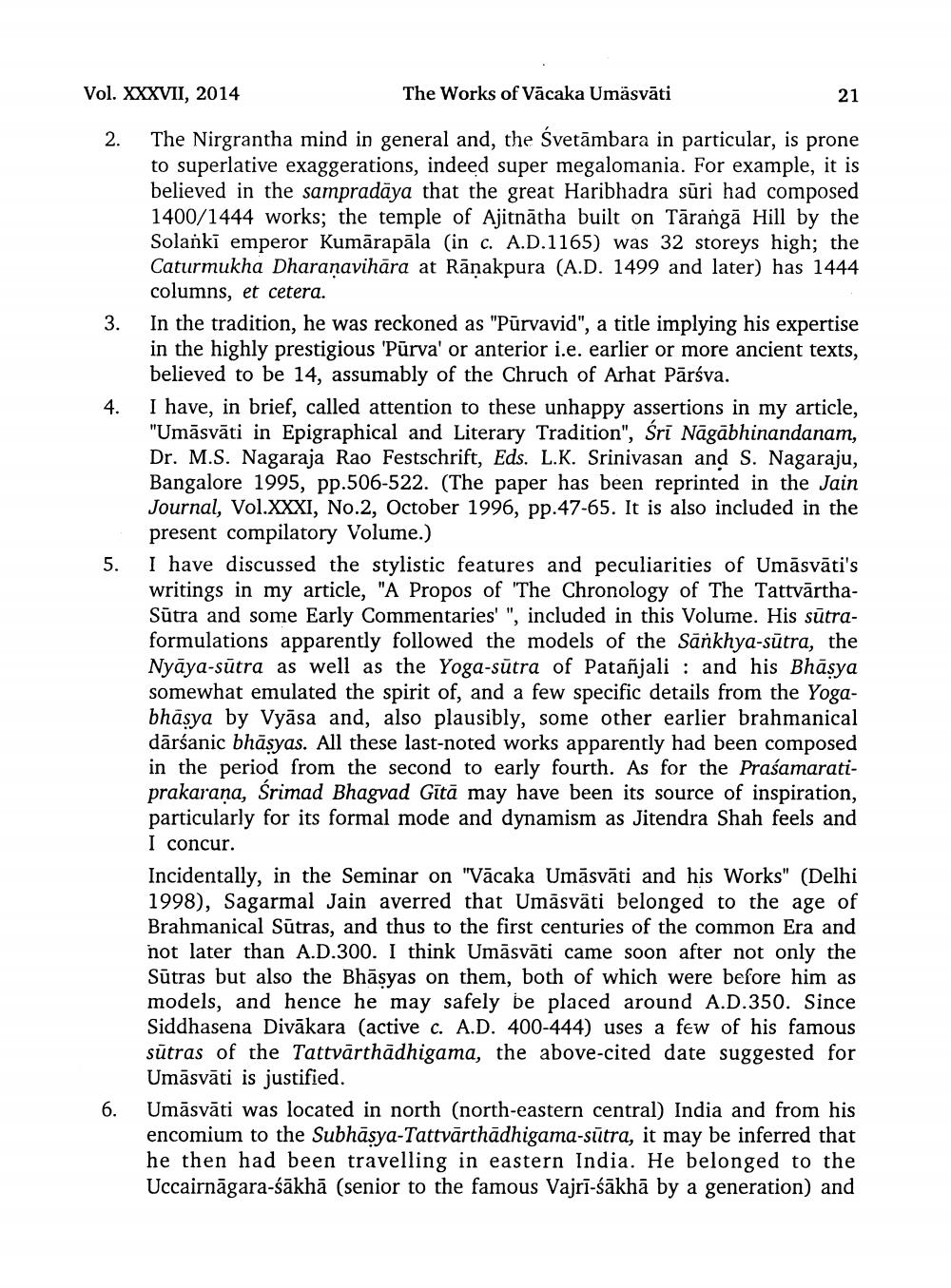________________
Vol. XXXVII, 2014
The Works of Vācaka Umäsvāti
21
2.
3.
4.
5.
The Nirgrantha mind in general and, the Svetāmbara in particular, is prone to superlative exaggerations, indeed super megalomania. For example, it is believed in the sampradāya that the great Haribhadra sūri had composed 1400/1444 works; the temple of Ajitnātha built on Tārangā Hill by the Solanki emperor Kumārapāla (in c. A.D.1165) was 32 storeys high; the Caturmukha Dharanavihāra at Ranakpura (A.D. 1499 and later) has 1444 columns, et cetera. In the tradition, he was reckoned as "Pūrvavid", a title implying his expertise in the highly prestigious 'Pūrva' or anterior i.e. earlier or more ancient texts, believed to be 14, assumably of the Chruch of Arhat Pārsva. I have, in brief, called attention to these unhappy assertions in my article, "Umāsvāti in Epigraphical and Literary Tradition", Śrī Nāgābhinandanam, Dr. M.S. Nagaraja Rao Festschrift, Eds. L.K. Srinivasan and S. Nagaraju, Bangalore 1995, pp.506-522. (The paper has been reprinted in the Jain Journal, Vol.XXXI, No.2, October 1996, pp.47-65. It is also included in the present compilatory Volume.) I have discussed the stylistic features and peculiarities of Umāsvāti's writings in my article, "A Propos of "The Chronology of The TattvārthaSūtra and some Early Commentaries' ", included in this Volume. His sūtraformulations apparently followed the models of the Sārkhya-sūtra, the Nyāya-sūtra as well as the Yoga-sūtra of Patañjali : and his Bhāsya somewhat emulated the spirit of, and a few specific details from the Yogabhāsya by Vyāsa and, also plausibly, some other earlier brahmanical dārśanic bhāsyas. All these last-noted works apparently had been composed in the period from the second to early fourth. As for the Praśamaratiprakarana, Srimad Bhagvad Gītā may have been its source of inspiration, particularly for its formal mode and dynamism as Jitendra Shah feels and I concur. Incidentally, in the Seminar on "Vācaka Umāsvāti and his Works" (Delhi 1998), Sagarmal Jain averred that Umāsvāti belonged to the age of Brahmanical Sūtras, and thus to the first centuries of the common Era and not later than A.D.300. I think Umāsvāti came soon after not only the Sūtras but also the Bhāsyas on them, both of which were before him as models, and hence he may safely be placed around A.D.350. Since Siddhasena Divākara (active c. A.D. 400-444) uses a few of his famous sūtras of the Tattvarthādhigama, the above-cited date suggested for Umāsvāti is justified. Umāsvāti was located in north (north-eastern central) India and from his encomium to the Subhāsya-Tattvārthādhigama-sūtra, it may be inferred that he then had been travelling in eastern India. He belonged to the Uccairnāgara-śākhā (senior to the famous Vajrī-śākhā by a generation) and




